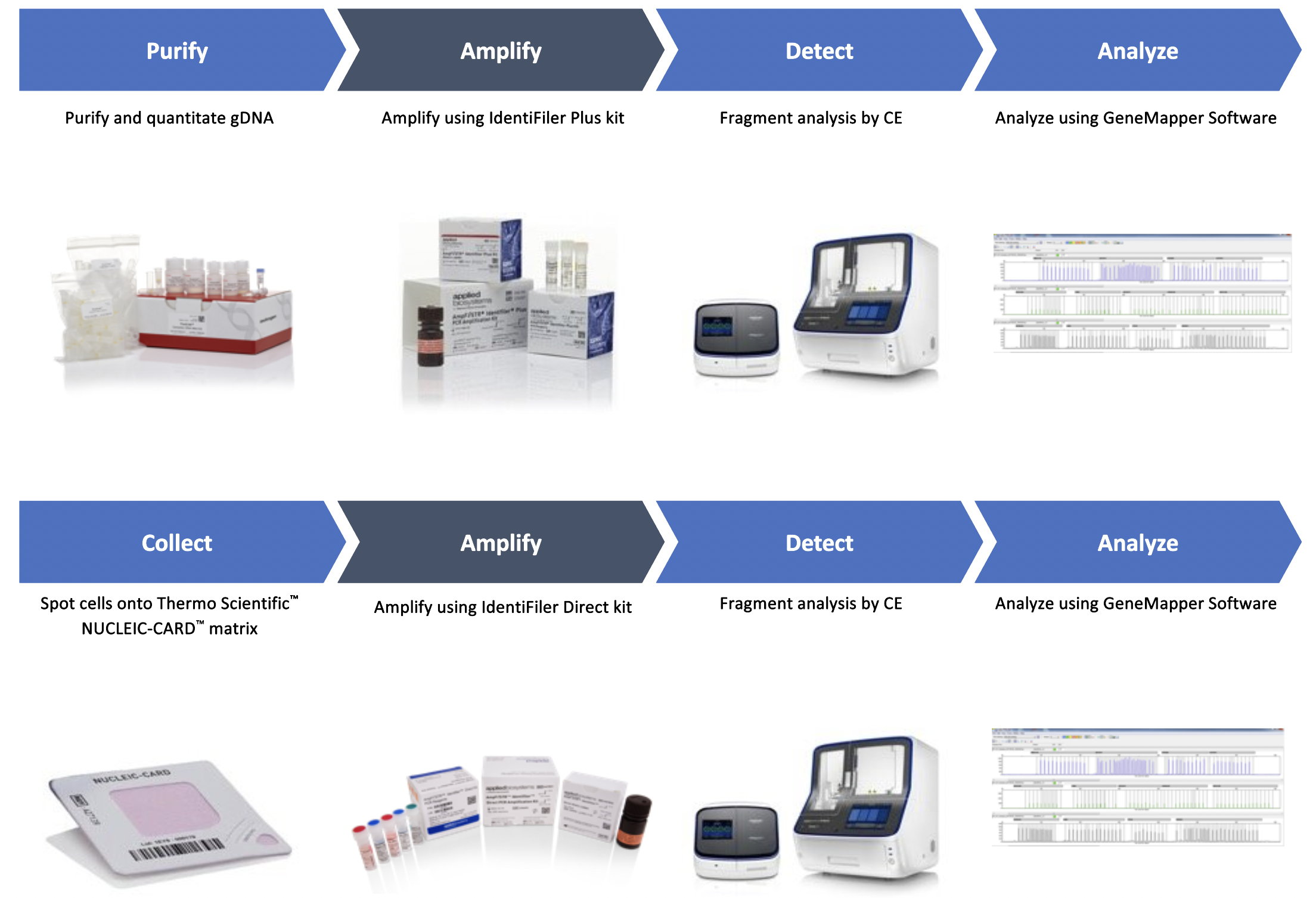
Best Practices for Cell Line Authentication
For academic researchers, biopharmaceutical companies, and institutional core facilities working with cultured cells, cell line authentication (CLA) is a critical quality control (QC) step. Proper authentication ensures that the cell line’s identity is verified and confirmed to be free of contamination from other cell lines or microbial sources.
Misidentified or contaminated cell lines remain a widespread challenge in life sciences. Human error during sample handling can easily lead to mix-ups, often caused by mislabeling, unclear or smudged labels, or accidental swaps of samples between vials1. These errors can lead to inaccurate results, compromised scientific integrity, and wasted resources. By integrating CLA into routine laboratory workflows, these risks can be significantly reduced and help ensure the reliability of experimental outcomes. As a result, many journals and funding agencies now mandate CLA prior to accepting papers or approving grants.
Among the various methods available, short tandem repeat (STR) genotyping is the gold standard for confirming the identity of human cell lines1,2. In this article, we provide practical advice and best practices for CLA, as well as strategies to avoid contamination and ensure the reliability of cell lines used in biomedical research.
1) Consult Trusted Resources
There are a number of reputable resources available for those new to CLA and seeking guidance. These include the ATCC introduced the ASN-0002 “Authentication of Human Cell Lines: Standardization of STR Profiling” consensus guidelines, which was later revised in 2022 (ANSI/ATCC ASN-0002-2022) and the “ISSCR standards for the use of human stem cells in basic research” published in 2023. These documents provide comprehensive guidance on the use of Short Tandem Repeat (STR) analysis for human cell line authentication.
Additionally, the International Cell Line Authentication Committee (ICLAC) provides many resources and best practice guidelines for researchers, including a curated register of cell lines already known to be misidentified or contaminated2,3.
2) Minimize Contamination Risks with Proper Cell Culture Techniques
Maintaining proper cell culture techniques and a sterile environment is crucial to prevent cross-contamination, especially for labs working with multiple cell lines. A clean tissue culture hood is essential for maintaining sterility. Avoid storing non-essential items in the hood and ensure it is regularly with a 5% bleach solution followed by 70% ethanol or isopropanol to remove contaminants to maintain a safe environment for cell culture work.
To further reduce the risk of cross-contamination, avoid handling different cell lines simultaneously in the same tissue culture hood—starting with the slow growers. Many steps in cell line handling, such as centrifugation or pipetting, can generate aerosol droplets that may transfer cells or media from one culture to another1. To minimize this risk, work with only one cell line at a time. Assign dedicated media bottles for each cell line, label them clearly, and avoid using the same pipette for transferring media between different cultures.
3) Test Upon Receipt and Quarantine New Cell Lines
Upon receiving a new cell line, immediately place it in quarantine, separate from other cultures, until it has been tested and known to be free of contaminants. Create both working and master stocks in a segregated space. Test an aliquot of the cells for mycoplasma and microbial contamination and generate a baseline STR profile. Mycoplasma contamination is a major problem in cell culture that often goes undetected and can have adverse effects on cell lines, altering cell behavior and metabolism in many ways. The STR profile can be compared with supplier-provided data or cross-checked against public databases like Cellosaurus to to verify the cell line’s identity before experiments begin.
4) Be Mindful of Passage Number
The passage number of a cell line—the number of times the cells have been subcultured—can affect cell behavior and experiment outcomes. Cells that have been excessively subcultured may no longer reflect the phenotypic and genotypic (genetic drift) characteristics of the original donor material1.
It is recommended to start experiments with low-passage cells and adhere to a predetermined passage range. Limit subculturing to no more than 20 passages to avoid undesirable cellular changes that may arise from extended culture1. Keep detailed records of passage numbers and regularly check cell morphology to track any phenotypic changes that could indicate a problem.
5) Authenticate, Authenticate, Authenticate
Authenticate cell lines at key stages of your research, particularly at the start and conclusion of a project. Re-authentication is especially critical after procedures like drug resistance selection or stable transfection to confirm that the cells remain authentic throughout the study3.
Frequent monitoring of cellular morphology is a simple yet effective method to assess the state of cells in culture. Morphological changes or unexpected growth patterns often signal underlying issues. When in doubt, always authenticate your cell lines. If issues persist, consider starting with a new vial from your working cell bank.
6) Use Validated Commercial STR Kits
For reliable CLA, STR profiling remains the gold standard in the industry. STRs are short (2–7bp) repeating sequences of DNA scattered throughout the genome where the number of repeated units varies significantly between individuals. The STR profiling process uses polymerase chain reaction (PCR) amplification of multiple STR loci from the genomic DNA, followed by fragment analysis using capillary electrophoresis (CE), to generate a unique genetic fingerprint for each cell line. This STR profile or fingerprint can be compared to a reference to verify the identity of a cell line.
While it may be tempting to create in-house or “homebrew” kits, these have not been validated and can yield inaccurate or unreliable results2. Commercial kits that include primers and reagents to test well-established STR markers offer the advantage of being well-validated, have been rigorously QC-tested, and are widely accepted in the scientific community.
Thermo Fisher offers comprehensive solutions for CLA through advanced CE instruments and commercial STR kits. Their thermal cyclers, including the VeritiPro™ and ProFlex PCR System™, and genetic analyzers like the Applied Biosystems SeqStudio™ and SeqStudio Flex Series, are optimized for CLA fragment analysis. The Applied Biosystems™ product line includes various PCR-based STR fingerprinting kits compatible with CE instruments, covering the 13 ANSI-recommended loci.
- CLA Identifiler Plus Kit: Analyzes 16 highly variable human STR loci from purified gDNA.
- CLA Identifiler Direct Kit: Analyzes 16 STR loci from dried blood, buccal spots (e.g., NUCLEIC-CARD), or buccal swabs.
- CLA GlobalFiler Kit: Offers 6-dye analysis of 24 loci for higher discrimination.
GeneMapper and cloud-based microsatellite analysis (MSA) software streamline STR analysis using pre-defined allelic ladders and bin sets.

Thermo Fisher’s tools enable robust STR profiling for quality control, ensuring the authenticity of cell lines, enhancing research reliability, and reinforcing scientific integrity. They remain committed to raising awareness and providing accessible CLA methods to combat cell misidentification challenges in research.
Final Remarks
Taking the appropriate steps to authenticate cell lines ensures that any new biomedical research is built on a solid foundation. By adhering to established best practices, researchers can generate data that is both reliable and reproducible, to maintain the integrity of their experiments. STR genotyping is the preferred method for cell line authentication, as there is a wealth of STR data available, which allows researchers to easily confirm the identity of their cells. It is a collective responsibility of all stakeholders in the scientific community to uphold the credibility of scientific findings—one that supports discoveries with the potential to improve human health and well-being.
Learn more about Thermo Fisher Scientific cell line authentication kits and resources
References
- Cell Culture Dish Podcast – Cell Line Authentication. Cell Culture Dish Inc; 2025.
- ATCC. Cell Line Authentication Test Recommendations. Published https://www.atcc.org/resources/technical-documents/cell-line-authentication-test-recommendations Accessed November 20, 2024.
- Souren NY, Fusenig NE, Heck S, et al. Cell line authentication: a necessity for reproducible biomedical research. EMBO J. 2022;41(14):e111307. doi:10.15252/embj.2022111307